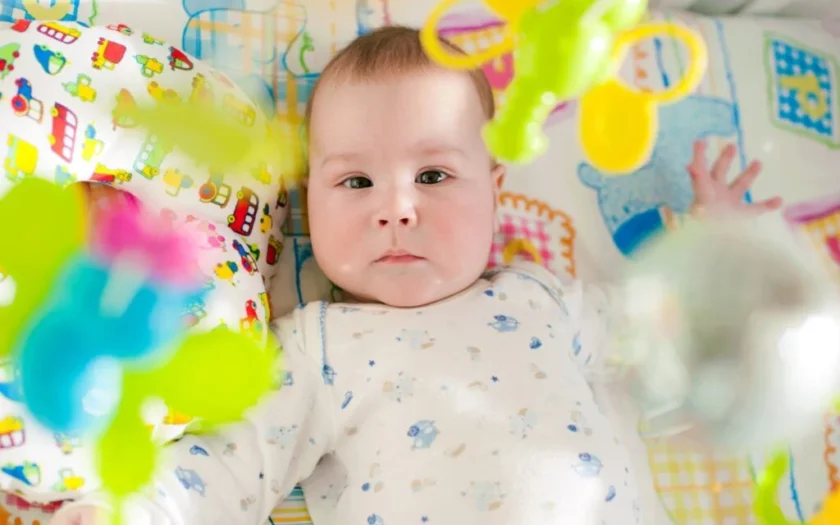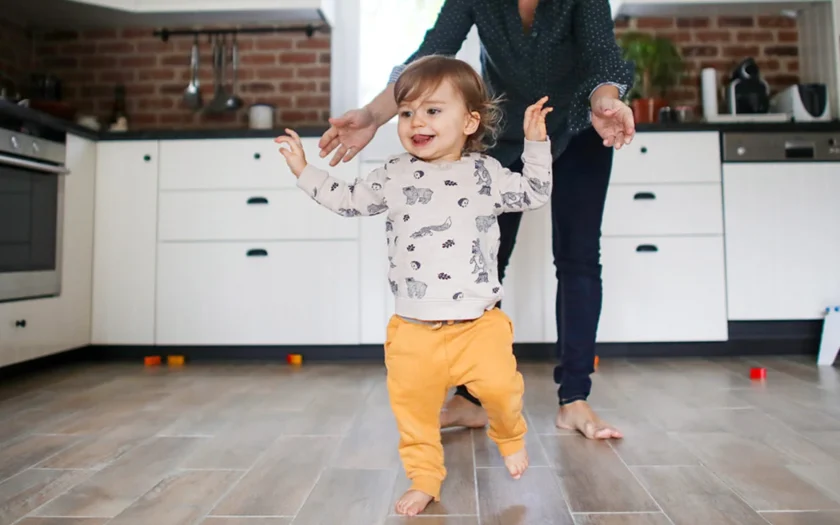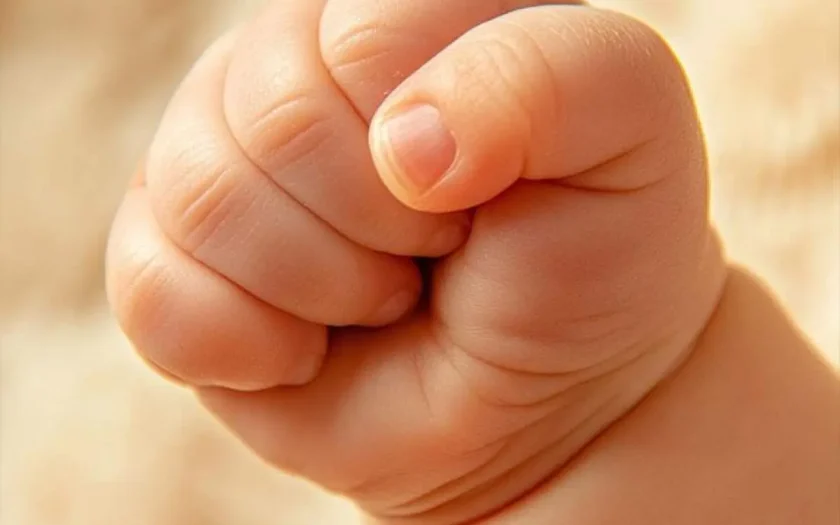How Do Colors Affect Baby’s Development?
Not surprisingly, color can have a notable impact on how baby’s vision develops—but it can also play a role in a child’s evolving language skills and emotional intelligence as they age. Below, a rundown of how colors can impact baby’s physical, cognitive and emotional development.
Cognitive and Visual Development
The American Academy of Ophthalmology notes that baby’s optic nerve—which is responsible for processing visual images by carrying them from the eye to the brain—grows rapidly in the first three years of life. Initially, newborns can’t see in full color, so most toys and board books for the first few months of life use bright images with high contrast (like black and white) and lots of white space, says Natasha Burgert, MD, FAAP, a Kansas-based pediatrician and Philips Avent expert.
These sharply contrasting colors, shapes, and patterns encourage baby’s development in many ways. First, they’re easier for babies to see and process compared to muted colors with lower contrast, says Jody LeVos, PhD, childhood development expert and chief learning officer at the education company BEGiN. Plus, they also help to boost “the development of optic nerves and encourage babies’ cognitive development without overstimulating them,” Hafeez explains.
Babies gradually begin to process more colors as they grow and can typically see the full color spectrum by 6 months old, Burgert says. “As children age, so do the cells in the eye.” And the more color baby sees, the better their retinas will begin to process them, says Carolyn Rubenstein, PhD, a licensed psychologist in Florida. She recommends paying attention to baby’s interest and how long they look at something. This can help determine when to add more colors to baby’s space to slowly stimulate their visual development and strengthen the bond between visual and cognitive processing. “Brain cells receive input from baby’s different developing senses that allow the nerves to expand and grow,” Rubenstein explains. “The more visual stimuli you provide, the more the baby’s retina matures, and the optic nerves progress.”
Emotional and Psychological Impact
Beyond visual and cognitive development, colors also play a role in influencing baby’s emotions and psychological state. “Color can evoke emotions, both positive and negative, and affect mood and behavior,” says LeVos. Bright and vibrant colors are often associated with happiness and energy, while softer, muted tones may convey calmness and tranquility.
For instance, studies have shown that exposure to warm colors like red and yellow can increase heart rate and stimulate brain activity, which might be beneficial for encouraging engagement and learning during playtime. On the other hand, cooler colors like blue and green are often perceived as calming and can help soothe baby during bedtime or moments of distress.
Moreover, the variety of colors in a baby’s environment can contribute to their overall sensory experience, influencing how they perceive the world around them. “By exposing babies to a range of colors, textures, and patterns, parents can enrich their sensory development and foster curiosity,” explains Rubenstein.
Conclusion
While the trend towards neutral colors in baby gear and nursery design offers a modern aesthetic, it’s essential to consider the developmental benefits of incorporating a variety of colors into baby’s environment. From enhancing visual and cognitive skills to influencing emotional responses, colors play a multifaceted role in shaping a baby’s early experiences and development.
Whether opting for vibrant hues or calming neutrals, balancing color choices in baby’s surroundings can create a stimulating yet comforting environment that supports their growth and well-being. Ultimately, understanding the impact of color on baby’s development allows parents to make informed choices that promote holistic development from the earliest stages of life.
Language Development
Colors also play a pivotal role in a baby’s language development. As babies grow older, they may develop a preference for bright primary colors. “Toys and objects in these hues could be especially interesting for them (as opposed to more muted hues like pastels),” explains Jody LeVos. Bright colors are attention-grabbing and provide an opportunity for parents to teach babies about what they see. “Though it will be many months before they start talking, it’s never too soon to describe the world around you and support language development,” LeVos advises. Parents can say things like: “Do you like the blue truck?” or “Look at this blue truck! This blue truck is the same color as this blue pillow.” This helps build the baby’s vocabulary for the names of different colors and helps them “make connections and notice patterns in their environment,” LeVos adds.
Sanam Hafeez further points out that younger children find it easier to remember colors than verbal cues, so adding colors to objects can aid in improving memorization. Additionally, many studies have linked certain colors to brain activity and stimulation. “From a young age, children associate colors with particular objects (i.e., yellow for the sun, blue for the sky). Colors help assess, estimate, and define objects,” Hafeez explains. “This can help a toddler learn and increase their attention span. For example, a child can link red to a firetruck associated with danger.”
Emotional Development
Pixar’s Inside Out wasn’t far off: as kids grow, associating colors with different emotions can help them process all their big feelings. By the age of 3, kids may associate yellow with happiness and blue with sadness. “Colors can enhance a child’s imagination,” says Carolyn Rubenstein. “Understanding color aids them in their creativity and comprehension of what each color is and what it represents.” This is also linked to the development of preschoolers’ verbal expression, as Natasha Burgert adds: “In order to coordinate color with emotion, there needs to be a connection between a visual stimulus, an emotional trigger, and the ability to verbally express the name of a color.”
While contrasting and bright colors are crucial as babies start to process and learn different colors, they may become overstimulating as your child grows older. Hafeez cites yellow as an example: while it’s a color associated with happiness, too much of it can cause stress. In fact, according to a 2016 study, play surfaces with lots of colors were found to be more distracting for preschoolers and older children. As your child grows, neutral and more calming colors may even help soothe them.
What Colors Are Best for Baby’s Development?
Experts agree that black, white, and high-contrast colors are optimal for baby’s early development, while a spectrum of colors can help them manage their emotions as they grow. But does this mean beige and neutral colors might hinder baby’s development? Not necessarily.
“While a toy that’s beige is not harmful, a toy with a bold black-and-white pattern (which has high contrast) will likely be more interesting for baby,” says Jody LeVos. “Having said that, you don’t need to turn everything black and white!” The good news is there are plenty of existing objects that provide sharp contrast that you may not even think about. “You may notice that baby is fascinated with the ceiling fan (even when it’s not on), which is an example of an object in the real world that already provides the type of contrasting colors baby craves,” LeVos explains. Luckily, these natural contrasts are easy to find and create, like putting a dark ceiling fan against a light-colored ceiling or a bright pillow on a light-colored chair. Plus, many baby toys feature primary colors and color-block patterns to provide the visual stimulation baby needs, so you don’t have to buy everything in a certain color or with a specific amount of contrast, LeVos adds.
The Bottom Line
Contrasting and bright colors are important for baby’s development, but it doesn’t mean you need to give up your love of neutrals and beige when it comes to baby’s gear. Most baby toys are designed with early development in mind, so as long as they have a good mix of neutrals and colors, baby will be just fine. If you’re ever concerned about baby’s visual or cognitive development, it’s essential to discuss it with your doctor.
“Visual development is directly related to other developmental goals,” emphasizes Natasha Burgert. “If you ever have concerns about vision or visual processing, reach out to your child’s pediatrician.”



